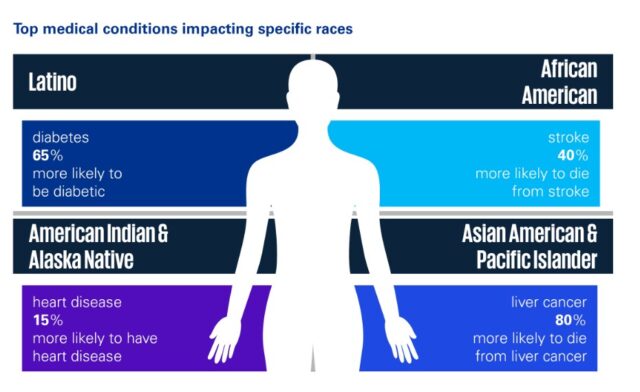

In America, the same city may encompass markedly different neighborhoods with divergent education, health care, home ownership, food quality and meaningful employment. These social determinants of health help determine whether a community will thrive or struggle. In Houston’s Harris County, for example, the lack of access to education and higher rates of unemployment, homelessness and poverty correlate with higher rates of death, diabetes, heart disease, obesity and other diseases compared with wealthier Houston neighborhoods.
Areas with larger racial minority populations often face worse health outcomes. Minority populations are rapidly growing throughout the United States, especially in Houston, where the higher number of minorities are straining the healthcare system. Focusing on broadband access, digital equity and genomics may be some of the most promising ways to usher in an era of health equity. If we fail to act, health disparities will only continue to increase.
Warning: Undefined variable $posClass in /home1/mjhnewsc/public_html/wp-content/plugins/ap-plugin-scripteo/lib/functions.php on line 1078

Warning: Undefined variable $posClass in /home1/mjhnewsc/public_html/wp-content/plugins/ap-plugin-scripteo/lib/functions.php on line 1078
In comparison, Houston’s population in 2021 was 44% Hispanic, 23.7% non-Hispanic White, 22.1% African American and 7.1% Asian.
Warning: Undefined variable $posClass in /home1/mjhnewsc/public_html/wp-content/plugins/ap-plugin-scripteo/lib/functions.php on line 1078
The table below represents the top medical conditions that impact specific races in the United States. Based on the demographics in Houston, a focus should be placed on programs that look to reduce the incidence of diabetes. While the Latino community is projected to continue to grow in Houston, it will also be imperative to focus on other programs that tend to impact other diverse communities. While SDOH will always be an important focus, the use of digital tools and genomics might have the greatest impact on reducing health inequities in these communities.


Broadband access
The Federal Communications Commission estimates that nearly 30 million Americans lack broadband access, which could lead to significant health consequences due to a lack of telehealth capabilities, no advanced communication channels, limited to no benefit of digital healthcare wearables and lack of personalized treatments. In areas with lower broadband connectivity, residents have higher rates of obesity, diabetes, unnecessary hospitalizations and sick days than national averages.
There are 24 residential internet providers covering 99.7% of Houston. This percentage is high, but more provider and internet options (cable, fiber, etc.) are in the northwest parts of the city compared with the east. As Houston and the overall healthcare industry moves more towards digital capabilities, lower income areas must have access to the appropriate level of broadband to take advantage of such digital offerings. More investment and appropriate policies are needed in Houston, and as part of a national strategy.
Digital equity
Even if broadband becomes more accessible in underserved communities, digital equity is needed to close the divide and transform health equity. Digital equity means all individuals and communities have the information technology capacity needed for full participation in our society, democracy and economy through digital inclusion and digital literacy. Digital inclusion ensures that all individuals and communities, including the most disadvantaged, have access to information and communication technologies. Digital literacy is the ability to use information and communication technologies to find, evaluate, create and communicate information, requiring cognitive and technical skills.
As technology advances, innovations are often focused on populations with higher incomes and education and are less relevant to the digital illiterate. While digital equity must include texts, portals, healthcare wearables, home health technologies, digital education and technology support, underserved communities must learn how to adopt and use next-generation technology.
Houston is working to improve digital equity, starting with adult literacy. The promise of digital healthcare capabilities impact on the most vulnerable communities cannot be realized without basic literacy. For example, in 2021, the Houston Mayor’s Office for Adult Literacy noted that “one in every three adults in Harris County lacks the necessary skills to participate and fully engage in the workplace and society.” In response, it developed Houston’s Adult Literacy Blueprint. Mayor Sylvester Turner noted that this program “is critical in strengthening our future workforce, the wellbeing of our neighborhoods, and the next generation of young learners. I envision a city in which every Houstonian has equitable access to the opportunities to gain the skills they need to succeed.”
In Houston and nationally, policies must include surveying communities on which technologies align with their needs and resources, and investing in digital literacy and digital inclusion for technologies to be useful to diverse communities.
Genomics
Life sciences and biomedical companies are investing millions of dollars in mapping the human genome for underrepresented populations. These advancements represent the fastest growth market in healthcare and could have a big impact on precision medicine and health equity. Genomics and precision medicine will define health equity in targeted cancer treatment for specific tumors, drug prescription and development, diagnosis of genetic diseases and personalized genetic health.
To realize advances in genomics and engage more marginalized communities in clinical trials, biomed institutions need to be closer to the communities they are collecting data from. This will create a sense of trust in these communities which should increase clinical trial participation. A recent study conducted by the federal government noted that the vast majority of biomed companies are not located in the communities that have the greatest need for biomed diversity.
As part of a national and local strategy, life sciences or biomed companies should be guided and potentially incentivized to move to communities they serve and enroll diverse populations in clinical trials to drive innovations in drug therapies and treatments. Houston is an ideal location, with over 1,760 life science companies and one of the highest densities of diverse populations.
While we have made great strides in health equality over the past five years, there is still more work needed. With the ongoing focus on technology, data and genomics, this new of health equity holds promise and should accelerate our progress toward reducing health disparities in Houston and nationwide.


